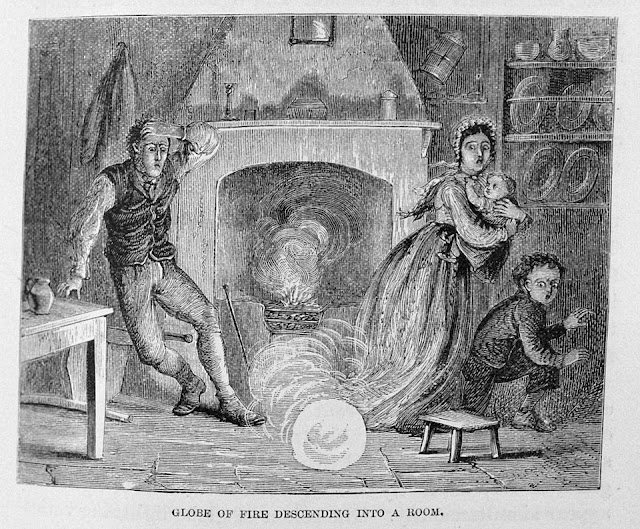 |
| Not all purple dragons are found near apple trees. This one, though, is. |
Tomorrow is my oldest kid's birthday. Over the weekend, he had his annual D&D birthday bash. Seems fitting then that I do a dragon today since they are his favorite (and he got like three of them for his birthday from his D&D group).
This is a repost, updated to better fit my "Occult D&D" project.
Dragon, Purple
aka Draco Arcanis Occultis, Arcane Dragon
FREQUENCY: Very Rare
NO. APPEARING: 1 (rarely 2)
ARMOR CLASS: 0
MOVE: 9” / 24”
HIT DICE: 9–11
% IN LAIR: 55%
TREASURE TYPE: H, S, U, Z
NO. OF ATTACKS: 3
DAMAGE/ATTACK: 1–8 / 1–8 / 3–28
SPECIAL ATTACKS: Breath weapon, spell use
SPECIAL DEFENSES: Resistance to magic (see below)
MAGIC RESISTANCE: Standard + bonus vs. arcane magic
INTELLIGENCE: Supra-Genius
ALIGNMENT: Neutral (Evil)
SIZE: L (45’ long)
CHANCE OF:
- Speaking: 90%
- Magic Use: 90%
- Sleeping: 25%
The Purple Dragon, also called the Arcane Dragon, is a rare and dangerous creature whose origins are cloaked in myth. Its scales shimmer in deep violet, often pulsing faintly with unseen magical energy. It is most frequently found in ancient ruins, planar nexuses, or near ley line convergences. Some scholars claim that Purple Dragons were once guardians of the primeval flows of magic itself.
Arcane Dragons are solitary and philosophical by nature, prone to periods of deep contemplation and magical experimentation. Their mastery of eldritch forces and unpredictable moods make them dangerous when provoked. Don’t however mistake this attitude for benevolence. Their contemplation of these eldritch and occult forces put them above the concerns of most mortals.
The Purple Dragon may employ the standard claw/claw/bite attack or its breath weapon, a beam of raw magical force:
- Breath Weapon: A beam of pure arcane energy, ½” wide and 12” long, affecting all in its path. This energy deals damage equal to the dragon’s current hit points, half with a successful saving throw vs. breath weapon. Victims struck must also save vs. spells or be stunned for 1–4 rounds due to arcane backlash.
Spell Use: All speaking Purple Dragons with magic ability cast spells as Magic-Users of 9th level, improving to 11th level at ancient age.
- 1st–2nd age categories: 2 × 1st-level spells
- 3rd–4th: +2 × 2nd-level spells
- 5th–6th: +2 × 3rd-level spells
- 7th–8th: +1 × 4th-level spell
- Ancient: 3 spells per level from 1st to 4th
Arcane Dragons are usually encountered alone, though some ancient tomes speak of mated pairs guarding planar gates or hidden vaults of magical lore. They construct elaborate lairs filled with wards, illusions, and enchanted guardians. Their hoards often contain rare magical scrolls, potions, and tomes in addition to treasure.
They may form tenuous alliances with powerful witches, warlocks, or archmages, often in exchange for secrets or artifacts.
Connections to the Scaled Sisterhood
Though the Scaled Sisterhood reveres the great dragon Patrons, Tiâmat, Bahamūt, Vritraxion, Lóngzihua, and Anantanatha, there are outlier dragons, revered by certain covens, that operate on the mystical rather than the primordial axis. Chief among these is the Arcane Dragon, Draco Arcanis.
Mystic Patron of Knowledge and Spellcraft
The first Arcane Dragon is honored by a coven of the Scaled Sisterhood known as the Order of the Violet Flame. These witches believe that while the elemental dragons represent the forces of the world, the Arcane Dragon embodies magic itself; pure, ineffable, and transcendent.
Witches of the Violet Flame often act as archivists, seers, and ritual specialists within the Sisterhood.
Their robes are trimmed in violet and silver, and their focus items are often made of crystalline dragon-scale or polished amethyst.
Their magical circles often incorporate symbols of sacred geometry, representing ley lines, runes, and arcane currents.
Dragon of the Nexus
The Arcane Dragon is drawn to leyline confluences and interplanar gates, making them ideal Patrons for witches who serve as gatekeepers, wardens, or planar navigators. The Scaled Sisterhood refers to such sites as Dracogates, where the breath of the Arcane Dragon is said to thin the veil between worlds.
Some believe the first Arcane Dragon was a child of Lóngzihua and Bahamūt, combining order and mysticism into a unique being beyond the elemental hierarchy, but was cast down or out for some long forgotten crime. This is the reason Purple Dragons in general are never recorded in official histories and bestiaries.
Others claim the first Arcane Dragon is a former consort of Tiamat, who was cast out for refusing to align with chaos or tyranny, choosing instead the neutral perfection of the arcane.
All other purple dragons are the offspring of this first Arcane Dragon.





















